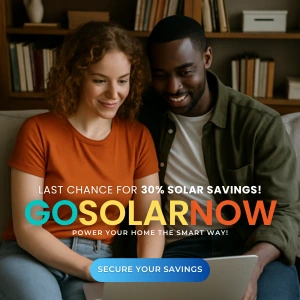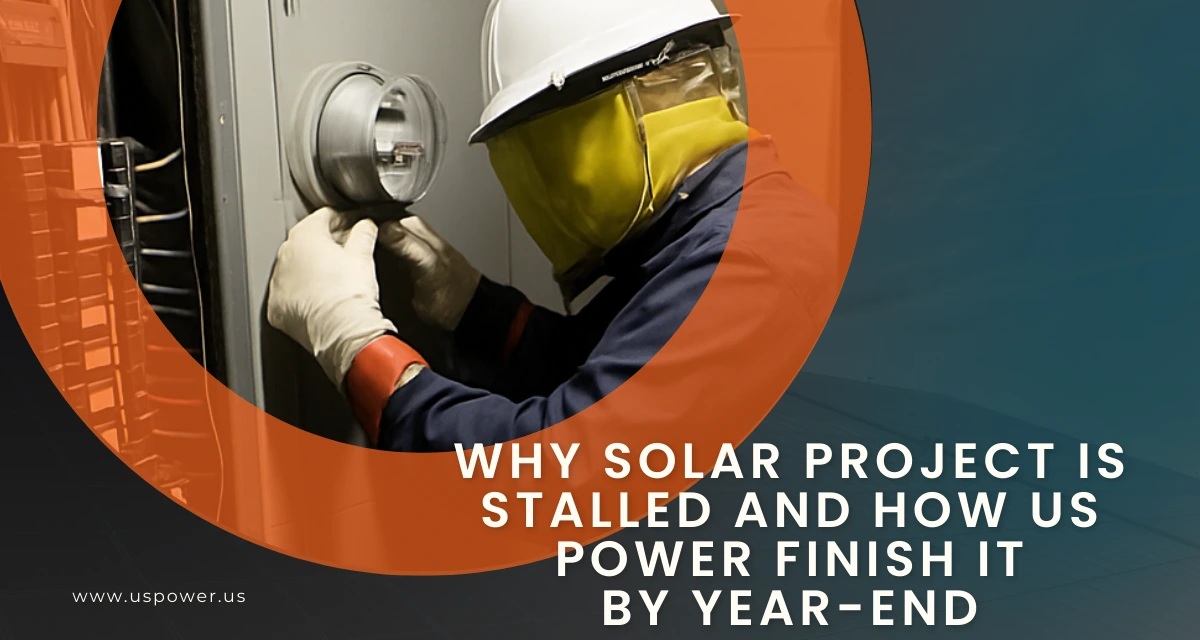Power Your Home & EV with Solar Before Incentives Slip Away

Solar and Roofing Advisor
Power your home and EV, avoid high electricity rates in SoCal. Secure your 30% federal solar tax credit in 2025 while powering your home with US Power!

If you're a Southern California homeowner thinking about going solar, there's never been a better — or more urgent — time. Electricity rates are high and climbing. Grid outages are no longer theoretical. And you don’t just want to power your home — you're planning to charge an EV too.
But you're wary: “What if I generate power but can’t use it all? Or worse, what if I send it to the grid and then buy it back later at higher rates?” Those are real concerns — especially now, as solar policy in California is shifting.
With a properly designed whole‑house solar system plus battery storage, you can:
- Charge your EV directly from your own panels
- Store energy for nighttime use or outages
- Avoid exporting too much to the grid — and rely less on it
- Lock in value before key incentives change or disappear
That’s where US Power comes in. As a factory-direct QCells partner, we can design and install a system tailored to your home + EV needs — and help you lock in the 30% federal solar tax credit before it potentially changes. Contact us today for a custom, no-obligation quote.
Why Combine Solar, Battery Storage, and EV Charging in SoCal?
In Southern California, high electricity rates, frequent grid stress, and the rise of electric vehicles make combining solar panels with battery storage an ideal solution. By integrating all three, homeowners can save money, stay powered during outages, and efficiently charge their EVs using clean, self-generated energy.
1. High Electricity Rates + Sunny Skies = Big Savings Potential
Southern California electric rates are among the highest in the U.S., which makes self-generation more valuable. By generating your own energy, you avoid paying steep utility costs and lock in long-term savings.
Learn how to control energy costs with solar.
2. Maximizing Self-Consumption with EVs
If you pair your solar array with an EV, you can use the daytime solar output to charge your car — rather than exporting excess energy or leaving it unused. In effect, your EV becomes a large “battery” (in consumption terms), and you're reducing grid dependence.
3. Backup Power & Resilience
Paired battery storage gives you backup during blackouts and ensures your home (and EV) stay powered. It's not just about saving money — it’s about resilience. For a deeper dive, see why every California homeowner needs a solar battery in 2025.
Recent Policy & Market Trends That Make This the Right Time
- Net Metering Shake-Up (AB 942): California’s AB 942 (amended May 2025) would require many legacy NEM (Net Energy Metering) customers — and future homeowners inheriting solar — to shift to newer, less favorable rate structures.
- Surge in Solar + Storage Adoption: In SCE’s (Southern California Edison) service territory, 82% of new solar applications included paired battery storage as of early 2025.
- Incentive Landscape: While California’s large-scale rebates are limited, the federal solar tax credit (30%) is still in play for systems placed in 2025.
- Battery Rebates via SGIP: Through California’s Self-Generation Incentive Program (SGIP), homeowners installing battery systems may get significant rebates, reducing the net cost.
How to Design a Whole-House + EV-Ready Solar System
Here’s a breakdown of key components, and how to think about designing your system to power both your home and EV:
Solar Panels
Use high-efficiency, QCells solar panels: reliable, long warranty, and available factory-direct with US Power. Design your array to produce enough energy during the day to serve your home, charge your EV, and (if sized properly) fill your battery.
Inverter & Charging Setup
Most home EV charging is AC-based, so you'll likely use a standard Level 2 EV charger. Inverter options: string inverters or microinverters. If you include battery storage, you’ll need an inverter/charger that supports that functionality.
Battery Storage
A battery lets you store excess solar energy and use it at night or when the grid is down. Given the recent policy trends, maximizing self-consumption via storage is becoming more critical — not just for savings, but for resilience.
Check how solar batteries can maximize your savings.
Backup / Islanding Capabilities
With the right system and inverter, you can create a “microgrid” mode: when the grid goes down, your home and EV can run off your solar + battery system.
Why DC‑to‑DC EV Charging Isn’t Typical (Yet)
Residential EV chargers are almost always AC. Most home EVSE (charging stations) and inverters work with AC. DC-to-DC (i.e., direct from panels to EV battery) is rare for residential setups. Vehicle-to-Home (V2H) or V2X (Vehicle-to-Grid) is promising but not yet mainstream for most homeowners. While some EVs and inverters support bidirectional charging, it's still an emerging market. For now, the reliable, cost-effective path is solar + battery + AC charger.
Sizing Your System for Home + EV Use
- Estimate Your Home Electricity Use: Review your past 12 months of utility bills to understand kWh consumption and peak usage.
- Estimate Your EV Charging Needs: For example, if you drive 100 miles/week and your EV gets ~3.5 miles per kWh, that’s about 28–30 kWh/week. Factor in efficiency and desired solar contribution.
- Match to Solar Production + Battery Size: Use solar modeling tools (or let US Power run the numbers) to determine how many panels you need. Choose a battery size that stores daytime excess for evening or backup use.
Costs & Payback: What to Expect in 2025
In California, the average installed cost is ~$3.14 per watt. For a 7.2 kW system, that’s ~$22,600 before incentives. Applying the 30% federal tax credit, the net cost drops to around $15,820. See solar panel cost analysis 2025 for more details.
Battery Costs
An average home battery (~13.5 kWh) costs about $15,600 pre‑incentive. With rebates and tax credits, the net cost is significantly reduced.
Incentive Savings
Combined incentives for solar + storage can total $13,480–$15,500, accelerating your return on investment.
Payback / Return on Investment
Net system cost: ~$24,000. Annual savings: ~$2,800–$3,200/year. Simple payback: ~7–8 years. Over 25 years, lifetime savings could reach tens of thousands, factoring in EV fueling costs and avoided outages.
Benefits Beyond the Financials
- Resilience: Keep your lights, EV charger, and critical loads running during blackouts.
- Environmental Impact: Charge your EV with solar to reduce carbon footprint.
- Future-Proofing: As V2H/V2G technologies mature, you’ll be ready.
- Home Value: Increase property market appeal with solar + battery.
Risks & Considerations
- Upfront cost
- Policy uncertainty (e.g., NEM rule changes)
- Permitting and design complexity
- Sizing risks (undersize or oversize)
- Maintenance/lifespan of inverters, batteries, panels
Why Trust US Power + QCells for Your Solar + EV System
- Factory-Direct QCells Panels: high-quality, American-made, full warranties
- Expert design tailored for home + EV: maximize self-consumption
- Professional installation & permitting handled by US Power
- Financing guidance & incentive help: federal, state, local rebates
- Resilience-first approach: islanding + battery backup
Next Steps: How to Move Forward
- Gather your past 12 months of electricity bills + weekly driving data
- Request a free assessment from US Power
- Explore financing & incentives
- Compare multiple quotes carefully
- Act before the federal solar tax credit changes
Take Control of Your Energy Today — Get Your Free Solar + EV Assessment!
Don’t wait for rising electricity rates, disappearing incentives, or unexpected outages to dictate your energy future. With a custom solar + battery system from US Power, you can power your home and EV efficiently, save on utility bills, and stay resilient when the grid goes down. Our factory-direct QCells panels, paired with expert design and professional installation, ensure maximum performance and long-term reliability.
Schedule your free assessment today and discover how easy it is to take control of your energy, lock in savings, and future-proof your Southern California home.
Artículos relacionados
Nuestros blogs relacionados
Finish your stalled solar project fast with US Power + QCells’ factory-direct panels.
See why Qcells panels are the smartest choice for California home solar in 2025.
Learn how US Power installs solar efficiently without compromising quality.
Nuestros socios de marcas de energía solar y techos








Empoderamos a las comunidades y las empresas para que aprovechen las energías limpias y renovables energía solar soluciones que impulsan el crecimiento sostenible.
Derechos de autor © 2025 US POWER | Energía solar y techosUS Power - Axia by QCells. All Rights Reserved.
La privacidad es importante para nosotros, por lo que tiene la opción de deshabilitar ciertos tipos de almacenamiento que pueden no ser necesarios para el funcionamiento básico del sitio web. El bloqueo de categorías puede afectar a su experiencia en el sitio web.
Imprescindible
Estos elementos son necesarios para habilitar la funcionalidad básica del sitio web.
Personalización
Estos elementos permiten que el sitio web recuerde las elecciones que ha realizado (como el nombre de usuario, el idioma o la región en la que se encuentra) y proporcionan funciones mejoradas y más personales.
Mercadeo
Estos artículos se utilizan para ofrecer publicidad que sea más relevante para usted y sus intereses.
Analítica
Estos elementos ayudan al operador del sitio web a comprender cómo funciona su sitio web, cómo interactúan los visitantes con el sitio y si puede haber problemas técnicos.
Nosotros y nuestros socios externos utilizamos cookies y otras tecnologías para mejorar y rastrear su experiencia en este sitio, realizar análisis y personalizar el marketing para usted. Al usar el sitio, aceptas que usemos estas tecnologías, incluido el registro y el monitoreo de tus interacciones con el sitio.
¡Obtenga una estimación solar instantánea usando el satélite!










